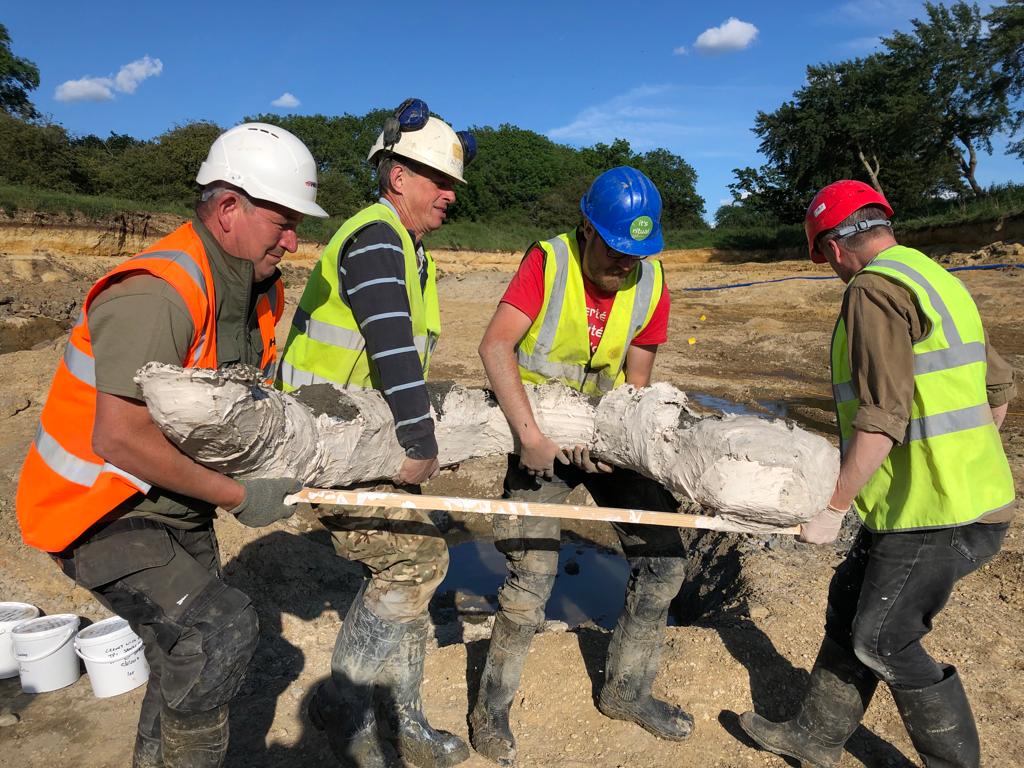
The remains, including two adults, two juveniles, and one infant, were uncovered at the quarry near Swindon alongside stone tools made by Neanderthals, in what experts are calling Britain’s most significant Ice Age discovery in recent years.
The excavations, which were led by archaeologists from DigVentures, unearthed what they says is astonishingly well-preserved evidence at the site, including delicate beetle wings and fragile freshwater snail shells, as well as stone tools and mammoth bones. Research is ongoing to understand why so many mammoths were found in one place, and whether they were hunted or scavenged by Neanderthals.
Dating evidence has revealed that the site was in use around 210,000 – 220,000 years ago, towards the end of a warm period known as MIS7 when Britain was still occupied by Neanderthals, before they were forced away by the increasingly cold temperatures that followed.
The discoveries are explored in a new BBC documentary ‘Attenborough and the Mammoth Graveyard’, with Sir David Attenborough and evolutionary biologist Professor Ben Garrod joining DigVentures on-site to film the excavations.
With archaeological sites from this period rarely so well preserved, these new discoveries will help archaeologists, palaeontologists, and palaeoenvironmental scientists address big questions about Neanderthals, mammoths, and the impact of a rapidly changing climate on life in Ice Age Britain.
DigVentures began investigating the site after two fossil-hunters, Sally and Neville Hollingworth, spotted a Neanderthal hand axe along with an impressive number of mammoth remains at a Swindon quarry.
Peter Andrew, group director for Hills Quarry Products, commented: “As the landowners, we are delighted to see so much interest in the discoveries from this site and to have facilitated such great research. We have a long-standing relationship with the Hollingworths and provided substantial resources to enable the excavations to take place, and will continue to support future investigations so that more discoveries can be made.”
Excavations, undertaken across two seasons in 2019 and 2021, revealed further evidence of Neanderthal activity on the site, including small flint tools called ‘scrapers’, which would have been used for cleaning fresh hides.
Lisa Westcott Wilkins, co-founder of DigVentures, said: “Finding mammoth bones is always extraordinary, but finding ones that are so old and well preserved, and in such close proximity to Neanderthal stone tools is exceptional. Words can’t quite capture the thrill of seeing a mammoth tusk still in the ground, or the feeling of standing in the middle of a site that has the potential to change how we see our closest human relatives and the Ice Age megafauna they shared their world with.
“There is still so much more to be uncovered here. The collaboration between scientists, landowners, and enthusiasts has been crucial, and we are already looking at how to continue the investigations and are exploring different ways that members of the public might be able to be part of it” she concluded.
Sally Hollingworth said “We were originally hoping to find marine fossils, and finding something so significant instead has been a real thrill. Even better than that is seeing it turn into a major archaeological excavation led by DigVentures, and a BBC documentary presented by David Attenborough."
The unusually high preservation of the site means that the team has also been able to recover crucial environmental and dating evidence. Some of the bones are now being examined for evidence of butchery, and further work is being planned at the site.
The work was funded by Historic England and supported by Dr Keith Wilkinson of ARCA at the University of Winchester, Hills Group Quarry Products, as well as a wider specialist team from several UK research institutions.













